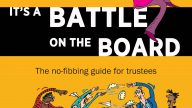Six traps for trustees to avoid when investing for charities
James Brooke Turner, author of Investing for Charities, offers his top tips on investing for charity trustees.
My new book on Investing for Charities looks at how charities invest in a new, charity centered and perhaps iconoclastic way. It’s a reminder for trustees that what makes them charitable is what they spend, not what they save. Given that you can only either save or spend your annual returns (you can never do both), I argue that a growing pile of money should be seen not as a measure of success, but a measure of failure – of what the charity has failed to spend on its purpose.
At the heart of the book is the idea that all charities should know if they are trying to grow, stay the same size, or shrink (after the effects of inflation, of course). The book refers to these as Financial Objectives and Goals and unless trustees can answer this question, they will have difficulty constructing a successful investment portfolio which does the most for the charity’s beneficiaries.
With this being said, here are six traps for trustees to avoid when investing for charities:
Forgetting that charity investments are only a means to an end
What makes charities is what they spend, not what they save. A growing pile of assets kept for no specific reason should be seen as a measure of failure (of what you could have spent), not success. The money is for the beneficiaries, and what matters most is what’s best for them.
Not knowing what you’re trying to do
All charities with investments will have fincial objectives. These will either be i) growing your investment pot to meet a particular target (such as creating a scholarship fund), ii) spending out on your charitable purpose over a number of years (such as building something), or iii) maintaining your portfolio against inflation for the long term. If you do not know the answer to this question you cannot even get to the next question.
Opting for ‘medium risk’
Most charities work across at least two time horizons, the near and the far and this determines your tolerance for investment risk, or better put, your tolerance for unpredictable investment returns. In the short term you will want to be certain that you can get your hands on your money at the value you expect it to have, so you won’t want any unpredictability in its value (ie low risk). If, on the other hand, you have a long time horizon (say of ten years) you’ll be able to accept far more uncertainty, for which you should expect far higher rewards (high risk). Only few charities will have one time horizon for which a ‘medium risk’ appetite will be appropriate.
Being confused about your reserve policies
Trustees are like a dam howling back a reservoir of financial resources, and a reserves policy is how trustees justify and account for all the money they have received which they are not yet able to pass on to their beneficiaries. A reserves policy is how your measure progress against your financial goals (see 2 above). Having ‘six months expenditure in reserve’ is usually a liquidity consideration and should be part of your investment policy. Be clear whether you are thinking about (liquidity (forward looking) or accountability (backward looking and in your reserves policy)?
Being recklessly cautious
The Charity Commission requires trustees to be prudent, not cautious. The difference is that sometimes it can be prudent to be incautious. Dealing with investment risk (‘uncertainty’) should always considered carefully which is different to just being constantly cautious. You would never say to a fundraiser ‘don’t try very hard’ and being recklessly cautious is the same.
Trying to cover every eventuality
Similarly, accept that there are some ‘game over’ scenarios which cannot be planned for, so do not try. If the world is stuck by a meteor or something similar, you will have bigger problems than the health of your investment portfolio.
James Brooke Turner is the author of Investing for Charities, a simple but powerful guide to putting spending on your beneficiaries at the heart of your investment policy. He is the co-founder of Yoke and Company, an investment consultancy for charities and their investment governance. You can buy a copy of his book here.


